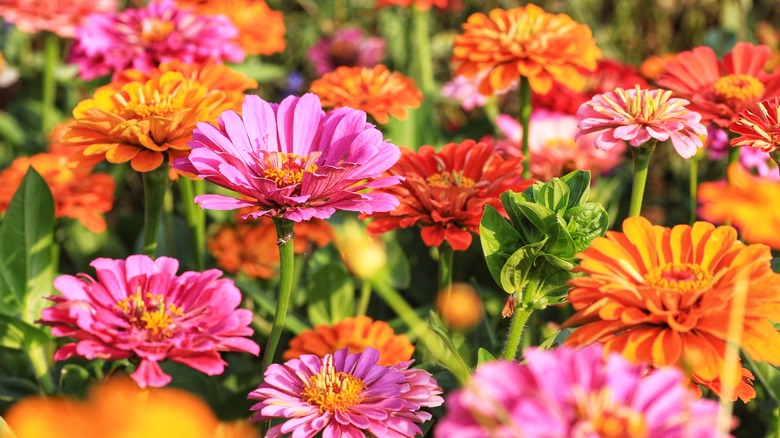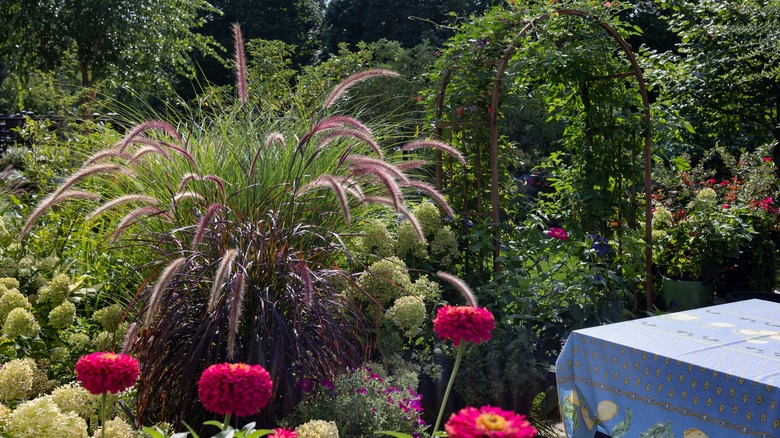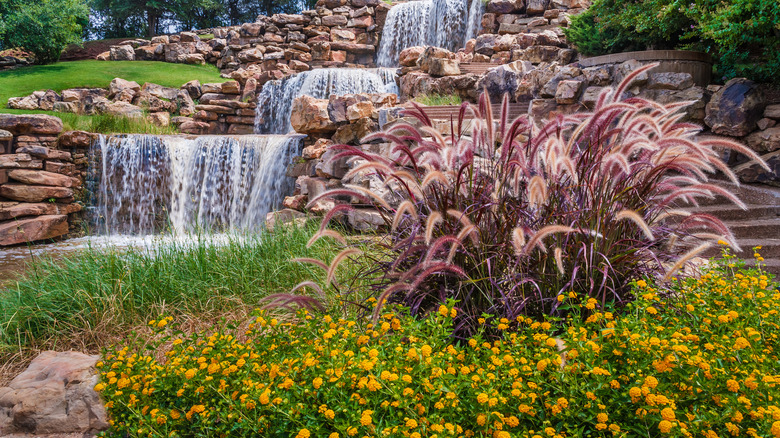The Ornamental Grass That Complements Zinnias While Attracting Pollinators
Zinnias are large, bright and bold flowers, with some varieties growing up to four feet tall. These show-stopping blooms deserve to be the center of attention, but pairing them with complementary companion plants can help them stand out even more — and encourage good garden health and pollination. Ornamental grasses are a popular filler plant in many flower gardens, but there's one variety that stands out above the rest with its royal plumage: purple fountain grass. Purple fountain grass is commonly seen in landscaped gardens and city parks because it fills in empty space quickly and is very easy to grow and maintain. If you're struggling to bring pollinators into your garden, especially in fall, purple fountain grass is the companion plant you need to turn your zinnia garden into an appealing all-inclusive retreat for pollinators.
Purple fountain grass is like the luxury high-rise apartment of the insect world, with great views, plush accommodations, and plenty of popular nearby eateries. Plant it in your garden beside the zinnias, and pollinators will love bouncing back and forth between the sweetness of the blooms and the safety of the tall grass. Here's what you need to know about planting purple fountain grass as a companion plant.
Purple fountain grass offers striking shelter
Purple fountain grass (Pennisetum setaceum) is an ornamental grass native to northern Africa and western parts of Asia. This tender perennial grass features a striking purple-ish hue and fuzzy, bobbing flowers that may sometimes be called "cattails," although they aren't the same as aquatic cattails. As a companion plant to zinnias, purple fountain grass can provide shelter to all sorts of invertebrates under its tall fronds. Its bright color and flower-like ends attract butterflies and bees and give them a place to rest in the tall leaves. Meanwhile, predatory pollinators like wasps will enjoy hunting prey in the foliage. By providing them with cozy places to rest and nest, these pollinators will pay a visit to your zinnia blooms as well.
Because it grows through late summer and fall in most climates, purple fountain grass makes a wonderful companion plant for zinnias, which also continue to bloom until the first frost of fall. In very warm areas, this ornamental grass can continue to grow year-round. As summer wanes into fall and most blooms disappear, pollinators struggle to find available food sources. Hangry bees and wasps are a real thing in the fall, becoming more aggressive as survival instincts take over. Planting zinnias and fountain grass varieties together in your garden is a great way to support these hungry pollinators, protecting them from chilly weather and offering sweet nectar in one convenient location.
Caring for your purple fountain grass
Purple fountain grass is a great companion to zinnias because they share similar care requirements. Purple fountain grass can be planted nearly any time of year while conditions are warm, but it is best planted in spring, giving it plenty of time to settle in before fall. This ornamental grass needs full to partial sun, and can be grown in containers quite happily, as long as it has good drainage and plenty of space to spread roots outward. This ornamental grass is drought-tolerant, needing only occasional rain once established. It's also deer-resistant, and attracts songbirds with its seeds, which will be ready in fall, and can even be harvested and replanted. While it's not native to North America, there is very little risk that this plant will take over your yard, making is one of the best colorful ornamental grasses to add to your landscape.
Purple fountain grass is classified as a tender perennial because it will die back and go dormant in winter, but may return if conditions are mild enough. In warm USDA zones 9-10, the plant is likely to return every year once it is established. In colder climates, you'll likely need to treat your purple fountain grass as an annual. To over-winter outdoors, cut the plant back in late winter. If you decide to grow in containers, you can bring the plant inside during winter and bring it back outside once warm temperatures return.


